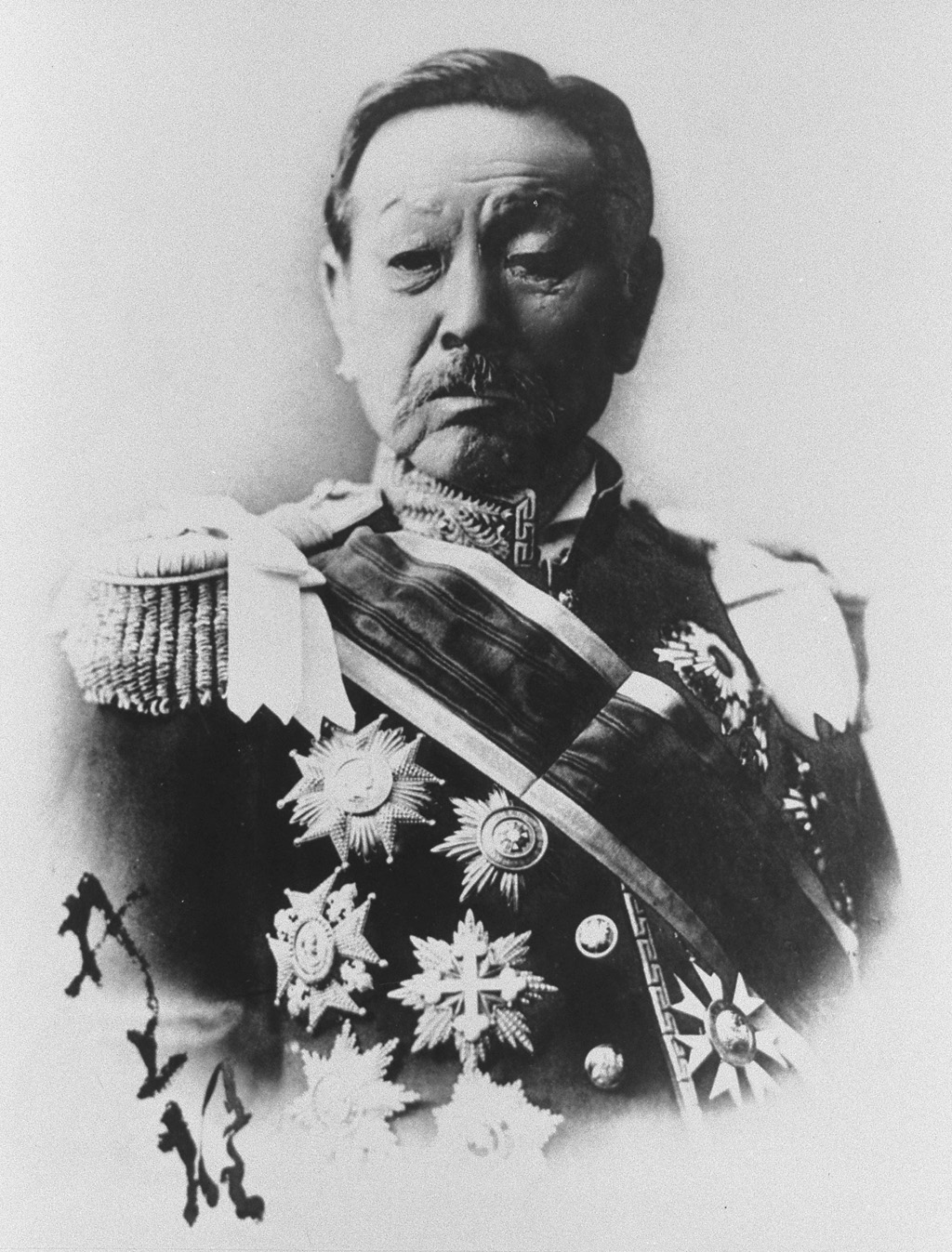- Inoue Kaoru
Infobox Politician
name = Inoue Kaoru
width =150px
height =200px
caption = Inoue Kaoru
birth_date =16 January 1836
birth_place =Hagi,Japan
residence =
death_date =death date and age|1915|09|01|1836|01|15
death_place =Shizuoka, JapanCount nihongo|Inoue Kaoru|井上 馨|Inoue Kaoru|extra= 16 January 1836 - 1 September 1915 was aJapan esestatesman and a member of theMeiji oligarchy that ruled Japan during theMeiji period (1868–1912).Early years
Born Yakichi (勇吉) to a lower-ranked "samurai" family in
Hagi ,Chōshū Domain (present dayYamaguchi Prefecture ), Inoue attended the "Meirinkan " Domain school with his brother Ikutarō (幾太郎). He was a close boyhood friend ofIto Hirobumi who later became Japan's first prime minister, and he played an active part in the "sonno joi " movement. In 1858, he studied "rangaku ",artillery andswordsmanship inEdo .In the
Bakumatsu period , Inoue emerged as a leader of the antiforeigner movement in his native Chōshū. Desiring to rid Japan of foreigners, he andTakasugi Shinsaku set fire to the British legation in Edo in January 1863.Recognizing Japan's need to learn from the western powers, he joined the
Chōshū Five and was sent to study atUniversity College, London in 1863. When he returned with Ito Hirobumi, he unsuccessfully tried to prevent war (theBattle of Shimonoseki ) between the Chōshū and the western naval powers over the closing of theStraits of Shimonoseki to foreign shipping. Later, he fought against the forces of theTokugawa bakufu in the 1864 “First Chōshū Chastisement Campaign”, during which he was severely wounded. He later played a key role in the formation of theSatchō Alliance against the Tokugawa shogunate.Statesman in the Meiji government
After the
Meiji restoration , Inoue served in several important positions in the newMeiji government . He was appointed Vice Minister of Finance in 1871 and was influential in reorganizing government finances on modern lines, especially in the reform of the land tax system, termination of government stipends to the ex-"samurai" and former aristocracy and for promoting industrialization. Closely linked to business circles, including the emergingMitsui "zaibatsu ", he was also involved in the railway business.These measures created many political enemies, and Inoue was forced to resign in May 1873.In 1876, Inoue was asked to assist in the field of foreign affairs, and was involved in the conclusion of the Japan-Korea Treaty of Amity as vice-ambassador extraordinary and
plenipotentiary . He returned to government as Minister of Public Works in 1878 and Foreign Minister in 1879. In 1884, he was elevated to the rank ofcount ("hakushaku") under the new "kazoku " peerage system.Under the
Meiji Constitution , Inoue officially became Japan’s first Minster of Foreign Affairs in the firstIto Hirobumi cabinet in December 1885. However, Inoue came under public criticism for his failure to negotiate a revision of theunequal treaties , his building of the "Rokumeikan ", and support of its Westernizing influences, which forced him to resign in August 1887.Later he served as Minister of Agriculture and Commerce in the Kuroda administration, as Home Minister in the second Ito administration and again as Finance Minister in the 3rd Ito administration.
From 1901, he served as most senior of the "
genrō ", and considered himself the government's foremost advisor on financial affairs. He died in 1915 at his summer home atOkitsu-juku ,Shizuoka prefecture .Reference and further reading
* Akamatsu, Paul. "Meiji 1868: Revolution and Counter-Revolution in Japan." Trans. Miriam Kochan. New York: Harper & Row, 1972.
* Beasley, W. G. "The Meiji Restoration." Stanford: Stanford University Press, 1972.
* Beasley, W. G. "The Rise of Modern Japan: Political, Economic and Social Change Since 1850." St. Martin's Press, New York 1995.
* Craig, Albert M. "Chōshū in the Meiji Restoration." Cambridge: Harvard University Press, 1961.
* Jansen, Marius B. and Gilbert Rozman, eds. "Japan in Transition: From Tokugawa to Meiji." Princeton: Princeton University Press, 1986.External links
* [http://www.ndl.go.jp/portrait/e/datas/18.html?c=3 National Diet Library bio]
Wikimedia Foundation. 2010.
